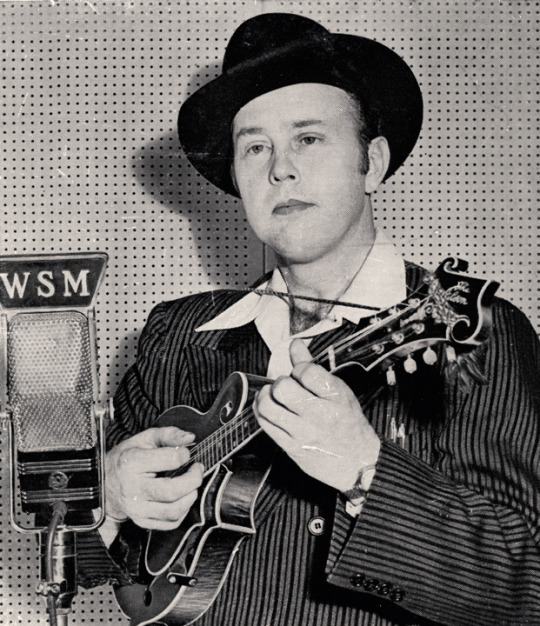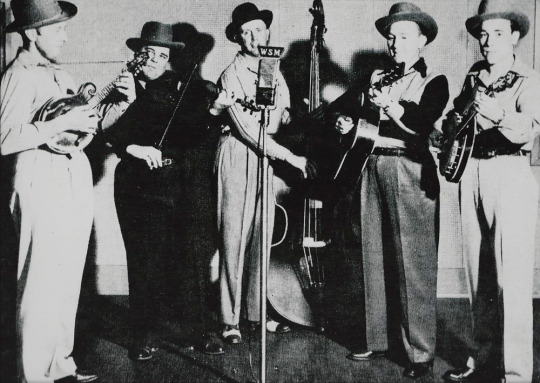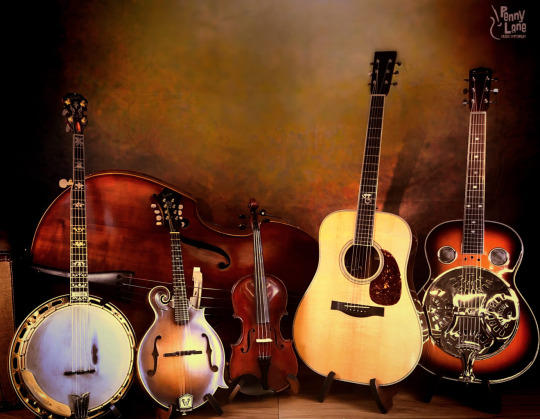#SHUT UP YOUR IMPOSTOR SYNDROME TRAP AND ACCEPT YOU KNOW SOME SHIT
Explore tagged Tumblr posts
Text
Bluegrass Basics #1
WHAT IS BLUEGRASS?
I realize that, what with this being a bluegrass blog and all, I should probably start by explaining... this.
If you’ve hung out with me in the last year and a half, then you’ve been subjected (probably against your will, kicking and screaming) to a Haddock Talks About Bluegrass conversation. Within seconds, you may be bombarded to an inescapable wall of sound as I shriek about G runs, five-strings, and dudes wearing hats named weird stuff like Lester, Burkett, Arthel, Dorris, Junebug, Haskel, and Chi Chi. Understandably, to cope and survive, your mind might have blocked out the worst of the memories... leaving you now with the question, “Well, what is bluegrass? And why does Haddock find it so cool?”
At its simplest, bluegrass is a folk-inspired genre of music originating from the Southern United States that utilizes a core group of acoustic string instruments: guitar, banjo, string bass, mandolin, fiddle, and dobro. However, bluegrass is not a direct preservation of old folk music. Its biggest influences are Scots-Irish fiddle tunes, African-American blues, and gospel music, and in that you can hear a lot of "old" sounds. But bluegrass also began within a commercial setting. Most people date it to the mid-1940s—yes, it's that new!—and it not only integrated new compositions and contemporary songs, but it brought about innovative instrumental techniques that most audiences had never heard before. Since its inception, bluegrass has been a music of unique juxtaposition; it's simultaneously homespun and commercial, simple and technically complex, straddling tradition with truly progressive innovation.
Also. Unlike almost every other genre that exist out there ever, bluegrass can be traced back to and centralized around a *SINGLE* human being. Yeah. That’s right. ONE dude essentially started his own motherfucking genre.
Enter: the Father of Bluegrass. Mr. Bill Monroe (1911-1996).
This guy.

1. HOW THIS SHIT GOT STARTED
Bill Monroe’s music at the time was considered hillbilly music. (“Hillbilly” was the name of the genre before we changed it to “country”). He was a radio star starting in the 1930s, and by the late 1930s, Bill and his band had become members of a popular, wide-reaching hillbilly music program, the Grand Ole Opry, whose radio signal stretched across the American South. Bill’s music wove together several influences: in particular, he combined the sound of old Scots-Irish fiddle tunes with the pitch bends, syncopation, and blue notes of African-American blues. For good measure, he chucked in four-part gospel songs, threw his singing into the high tenor stratosphere, and pushed the music forward with an urgent drive.
And the name of his act? Bill Monroe and the Blue Grass Boys.
Hmhm... something sounds familiar here... something to do with “blue” and “grass,” maybe.
Bill’s music underwent changes, different personnel, different instruments. Every musician’s contribution is important and worth noting, but regrettably my post would be too long if I talked about them here. I will, however, mention what’s often considered the last piece of the puzzle. On December 8, 1945, Bill introduced a new musician he had just hired, a twenty-one year old banjo picker whose style of playing was so unexpected to audiences that you could barely hear the music above the amazed cheers and shouts from the live crowd. People who heard it on the radio talked about the banjo picker all week; some blokes debated about whether one person was playing or several, or if it was even a banjo at all. I know peeps today don’t tend to think of banjos as “cool” and all, but he was shredding up the instrument like some banjo Jimi Hendrix, as far as they were concerned. It was so exciting. Bill was already a popular performer; under this ensemble he had between then and 1948, he was launched to even more popularity.
I’m not trying to focus just on the banjo, but my point here is to emphasize how bluegrass did invoke monumentally new ideas.
That 1946-1948 group is what we usually consider the first-ever bluegrass band. They created the initial blueprint by which a unique band style emerged. Now, some standard musical features of the genre got locked in during the 1950s after several seminal Blue Grass Boys bandmates left and formed their own band. But this original group’s sound started A Movement™ that trickled down over the decades. New-budding musicians began imitating Bill’s sound in their bands. And also, Bill’s band had constant turnover, meaning that a ton of people went into the Blue Grass Boys, got influenced by Bill, then left to form their own ensembles, carrying with them the musical ideas they’d learned from Monroe.
(And by “constant turnover,” I mean—no joke—Bill had something like 200 official band members over the course of his career.)

^^^ The “Classic Band” of Bill Monroe and the Blue Grass Boys, c. 1947. From left to right: Bill Monroe (mandolin), Chubby Wise (fiddle), Birch Monroe (bass), Lester Flatt (guitar), and Earl Scruggs (banjo). When talking about the classic band, the bassist usually listed is Cedric Rainwater, but here (and legitimately part of the band at the time) is Bill’s older brother Birch.
In the late 1950s and 1960s, mainstream country music had to find a way to compete with the new and oh-so-frustratingly-popular rock-and-roll. Mainstream country music strayed away from scratchy fiddles and banjers and moved to smooth, pop-inspired, electric guitars and background orchestration. And if you didn’t sound like that, you probably weren’t going to be played on mainstream country radio. But there was a notable cluster of acoustic string band musicians who had been left behind... those people and groups who had branched straight off Bill Monroe. By this point, they were distinct enough that their music began to be regularly referred to as... yeah, you guessed it... bluegrass music.
Having been ignored by radio, bluegrass continued through other means, such as festivals that began in the late 60s and 70s. Many musicians brought their own instruments to jam, and to this day, bluegrass is a genre in which it’s common to both pick tunes with friends and family as a social event and go out to see professional performers.
As new generations have entered bluegrass, new ideas and sounds have funneled into it. However, I feel like the theme of combining tradition with innovation remains. For instance, in the 1960s with the Folk Revival, second generation bluegrass musicians simultaneously inserted more several-centuries-old folk songs into the bluegrass repertoire (ex: Fox on the Run), and brought in contemporary rock and pop elements to their bands’s sounds. And while today you may meet bluegrass purists who want to stick with what they heard in the 40s and 50s, you’ll see just as many if not more musicians continue to innovate and expand the genre.
And expand it they will.
youtube
2. WHAT MAKES BLUEGRASS MUSIC BLUEGRASS?
As I’ve said before, bluegrass is a somewhat progressive amalgamation and reformulation of older music styles combined with contemporary music. Bluegrass might have been based in part on ideas from British Isles fiddle tunes and African-American blues, but it’s certainly not regurgitating how people played in decades past. Familiar, old elements combine with new, creative, and original concepts. You keep a healthy dose of both old and new.
It’s because of bluegrass that the banjo was completely reformulated as an instrument: changed from a comedic prop that was strummed into an intensely-picked solo instrument. Within bluegrass, banjo performance technique has continued to evolve, new ideas and styles building on top of one another. And let’s not forget the other instruments! The first dobro in a bluegrass band went in extremely unique directions compared to what was heard at the time, taking influences from everything down to banjo technique. At the same time, bluegrass has provided the space for styles like the old-time hoedown fiddle in periods of music where fiddle was ignored.
But....... as you’ve probably been wondering this entire post.... what does this genre sound like?

^^^ The typical instrument set-up for a bluegrass band. In the back is a string bass. In front, left to right, is a banjo, mandolin, fiddle, guitar, and dobro. If you’re not familiar with how to distinguish instruments: basses are plucked and low pitch; banjos sound twangy and play short note values; mandolins are a high-pitched instrument with a mellower sound that often employ tremolo (quickly undulating notes by strumming the strings up and down rapidly); fiddle is... I mean, it’s a violin; guitar is a mellower acoustic instrument that blends sonically with everything; and the dobro (maybe you’ve heard it referred to as a “steel guitar” or “Hawaiian guitar”) has a... uhhh... it’s a unique hound dog tone I have difficulties describing but is very distinct to hear.
A typical ensemble consists of mandolin, guitar, banjo, fiddle, string bass, and sometimes dobro. On rarer occasions, you may see other instruments like autoharp or harmonica (drums are usually considered horrible, forbidden things, even though... for the record... some high-profile bluegrass bands have used them). You’ll notice bluegrass is a distinctly acoustic string band sound.
There are also, of course, vocals, and in bluegrass, there is notable emphasis on tight two-, three-, and four-part harmony. However, what’s interesting about bluegrass as versus, say, other strains of country, is that for bluegrass, it’s about the full band and not just the lead singer. It’s as important to pay attention to the technically-driven solos (“breaks”) that the instruments play between sung verses. Many bluegrass pieces are straight out instrumentals, too.
Every instrument has a role or roles it fulfills in a bluegrass band. In the background, instruments may play rhythm or fills. Rhythm keeps the basic beat. Fills are unobtrusive melodic-sounding fragments that hide behind the vocalist(s) singing the main melody. And when there’s no singing, instruments take turns in the spotlight playing breaks. You can hear any instrument play a break. It’s to note that breaks are often improvised or semi-improvised, which is half of the fun and skill of watching the musicians perform. Ergo, even if the song itself may or may not have simple chord structures and lyrics, it’s also technically advanced with an expectation that every musician can perform fast-paced solos they improvise on the fly.
There’s different types of guitar styles I’ve seen in bluegrass. I’m not a guitarist, so I don’t want to elaborate too far and share incorrect information. However, it’s fair to say that guitar can be anything from a backup rhythm chord strummer to a flat-picked, fast-paced, melodic soloist. There is a VERY distinct guitar fill that happens at the end of lines, phrases, or sections called the G run you’ll hear everywhere. Fiddle I’ve also heard a wide variety of styles. On the dobro side, the dobro tends not to be the “Hawaiian” sound you may be familiar with on a steel guitar, but more geared toward quick, technical, bluesy stuff. Bluegrass banjo has several styles, but the most prototypical is the Scruggs style, where the banjo does rapid-fire, ornamented, three-fingered picking in which a melody line is pulled out at the same time you’re also picking background chord notes.
To describe bluegrass vocals, you’ll sometimes hear the phrase “high lonesome” thrown around. I don’t hear anywhere as much high lonesome sound in contemporary bands as I do first generation, but the high lonesome sound is a description of piercing, high-range vocals. Bill Monroe would even take songs that were usually played in the key of G and pitch them higher into A or B, pushing his and the ensemble’s vocals into a higher range. I remember listening to Monroe and thinking to myself, “Even though it’s male vocals, why is it so easy for me to sing to?” Because I’m a fucking mezzosoprano, and there’s times Monroe hits and holds notes that are at the top of my range. Hot damn.
youtube
Rhythmically, bluegrass tends to be a driving genre of music. A term that gets thrown around a bit is “drive.” Even on the slow songs, you may hear the instruments push or strain forward. Beat-wise, bluegrass tends to emphasize both a strong downbeat and hit heavy offbeats in a boom-chick style. That last sentence might not have made sense to non-musicians, so I’ll explain...
When we listen to music, we can clap to it. We can also count along to any song as we clap. Music has an innate structure where, when we count, the sound seems organized in groups of two, three, or four. So, when we count to music, we’ll count repetitively. One song may be groups of two (you’ll count “One two, one two, one two”), groups of three (“One two three, one two three”), or groups of four. Every time you hit the “one,” it sounds bigger. It’s more emphasized. It’s restarting the pattern or unit of counting that’s inherent to the rhythmic structure of music.
Now, you can subdivide those numbers between your claps. That means you’d count “One (and) two (and), one (and) two (and),” where the “ands” tend to feel smaller and less-emphasized. Those “ands” are called offbeats. In bluegrass, you’ll hear both the numbers and the “ands” clearly hit. The string bass will play the one’s and two’s, while perhaps the mandolin and banjo are emphatically hitting the “ands” in the background.
There are subgenres within bluegrass. You may hear people refer to newgrass, progressive bluegrass, jamgrass, punkgrass, etc. Put a word in front of it, add the word “grass,” and it probably exists. Jewgrass exists and it’s awesome. There’s fusions, too. The Native Howl is a band that combines thrash metal and bluegrass. Gangstagrass is a band that combines bluegrass with hip hop. It’s also to note that bluegrass has long since become international, and there are notable communities and bands of bluegrass from everywhere to Japan to the Czech Republic.
3. RECOMMENDATIONS FOR GETTING STARTED?
Ummhmhmhm I honestly need a separate post to begin sharing videos, bands, periods of bluegrass, and more. It’s diverse and I love everything from the music coming out in 2020 to the stuff heard in 1947.
I realize that this post skews more toward first generation bluegrass and the starting bands in Ye Olde Days. Because of that, I’ll say this much: the Big Three bands of the early years were Bill Monroe and the Blue Grass Boys, Flatt & Scruggs and the Foggy Mountain Boys, and the Stanley Brothers and the Clinch Mountain Boys. Bill Monroe’s music is “the original” and is based, at least in his mind, the most on the fiddle tunes he grew up with. Flatt & Scruggs skew somewhat more toward a popular culture sound with smoother vocals and instruments like the dobro that other early bluegrass bands did not use. The Stanley Brothers lean the most to mountain old-time music. Every band is wonderful in their own way and I love listening to all.
I’ll leave this post with what was my gateway song into bluegrass. This was the first song I listened to with the intent of experiencing bluegrass, not expecting to like it, but being pleasantly surprised. I fell in love with the song and... well... as you’ve seen... I’m a year and a half into the genre and still charging strong.
youtube
I look forward to continuing to learn about bluegrass, refine my understanding of it, and share those discoveries with y’all in my future posts.
#thatbanjobusiness#that banjo business#music#I keep being nervous to post INFORMATIVE posts on these topics being like#'what if I got something wrong???'#bruh [talking to myself]#HOW MANY MOVIES AND VIDEOS AND DOCUMENTARIES AND INTERVIEWS AND BOOKS HAVE YOU GONE THROUGH#SHUT UP YOUR IMPOSTOR SYNDROME TRAP AND ACCEPT YOU KNOW SOME SHIT#besides I can always hide behind 'well I JUST STARTED getting into the music'#which is true#to be clear: I did not grow up with this music#so bear that in mind with all my posts#I am LEARNING and EXPLORING for the first time in my late 20s#Bluegrass Basics#blabbing Haddock#General Banjo Business#Country Music History#Bill Monroe#daddy boi billiam#music history events
13 notes
·
View notes